 |
|
AMERICAN POLITICAL PARTIES SYNOPSIS |
|
FEDERALISTS
|
DEMOCRATIC-REPUBLICANS
|
| During most of George Washington's presidency, no real two-party political system existed. The Constitution made no provision whatever for political parties. While its framers recognized that reasonable disagreement and organized debate were healthy components in a democratic society, creation of permanent factions was an extreme to be avoided. (The consensus among the founding fathers was that political parties were potentially dangerous because they divided society, became dominated by narrow special interests, and placed mere party loyalty above concern for the common welfare.) Hence, to identify Washington with the Federalist Party is an ex post facto distinction. Accordingly, Washington's first "election" is more accurately described as a "placement"; his second election was procedural only. The first presidential challenge whereby the citizenry genuinely expressed choice between candidates affiliated with two separate parties occurred in 1896, when John Adams won the honor of following in Washington's footsteps. |
 |
| The cartoon above shows the infamous brawl in House of Representatives between Democratic-Republican Matthew Lyon of Vermont and Federalist Roger Griswold from Connecticut. Lyon responded to a verbal insult from Griswold by spitting in Griswold's eye. Still seething two weeks later, Griswold used his cane to pummel Lyon, whereupon Lyon retaliated with some fire tongs. Before long, the two were grappling on the floor. All this occurs to the apparent delight of their legislative colleagues, who appear to enjoy the impromptu brouhaha. Another congressman lamented that the incident had reduced Congress to "an assembly of gladiators." Soon afterward, poor Lyon became the first person convicted by the Federalists of violating the Sedition Act of 1798. His crime? The lawmaker accused President John Adams of having "a continual grasp for power—an unbounded thirst for ridiculous pomp, foolish adulation, and selfish avarice." |
|
JOHN QUINCY ADAMS
|
WILLIAM CRAWFORD
|
|
HENRY CLAY
|
ANDREW JACKSON
|
| The Democratic-Republicans faced no serious opposition in the presidential election of 1824, but the party could not unite under a single candidate. The result was a general election deadlock which forced the decision into the House of Representatives, where John Quincy Adams was elected on the first ballot over Andrew Jackson, who had garnered the most popular votes (presumably, electoral votes as well) in the general election. There was some apparent deal-making prior to the House vote. Henry Clay, finishing fourth in the popular election and therefore eliminated from further consideration, urged his House supporters to back Adams. When Adams became President, he appointed Clay as Secretary of State, considered then, every bit as much as the position of Vice-President, to be the stepping-stone to the White House. Hence, Jackson and his supporters bitterly protested the affair as a "corrupt bargain." While there may be some small degree of validity to a political deal (that it was somehow corrupt is baseless), often ignored is the fact that in 1824 the popular vote was not an altogether accurate indicator of the people's will because very few states had all four candidates on the November ballot (several states had only two). Additionally, six states chose electors through their state legislatures rather than general election. Unfortunately for Adams, he was out of his realm as President. Historically, his mediocre presidential term overshadows an otherwise stellar political career of service to the United States, especially in foreign affairs. As for Clay, he never did make it to the White House. |
|
JEFFERSONIANS
|
JACKSONIANS
|
| The Democratic-Republican Party arose in response to what many Americans viewed as a Federalist Party becoming increasingly neglectful of public interest. While members of the new party called themselves "Republicans," they are not related to the modern Republican Party but instead are considered by many historians the rudiment of today's Democratic Party. Thomas Jefferson and James Madison provided strong early leadership for the Democratic-Republicans. In the so-called "Revolution of 1800," the electorate ousted the distant, monarchical-acting Federalists in favor of comfortable, old-fashioned democratic principles championed by the Democratic-Republicans. When Andrew Jackson was elected to the White House in 1828, he thrust America into a democratic experience even more grass-roots than that of the Jeffersonians before him. Some historians are reluctant to trace the modern Democratic Party all the way back to Thomas Jefferson, preferring instead to credit Jackson as the present-day party's ancestral standard-bearer. Perhaps a suitable historical image of the Democratic Party would be a circle outlined by Jefferson, plenished by Jackson. Ironically, Jefferson did not care for Jackson's brash form of democracy, once calling Jackson a politically "dangerous man"; the puritanical John Quincy Adams (Jackson's predecessor and major opponent in the presidential elections of 1824 and 1828) referred to him as a "barbarian." |
|
DEMOCRATS
|
WHIGS
|
| The several diverse factions which fused to create the Whig Party actually had little ideology in common, though the coalition possessed great resources of wealth and talent. Political giants John C. Calhoun, Henry Clay, and Daniel Webster all identified with the Whig Party at some point in their distinguished tenures. Additionally, John Quincy Adams switched to the Whigs after his presidency; Abraham Lincoln began his political career as a Whig. The chief immediate obstacle ahead for the Whigs was to somehow overcome the public perception that since the party staunchly opposed Jackson, it therefore stood in conflict with the major trend of the age—glorification of the common man. The Whigs managed to overcome this ideological bump in the road by portraying themselves as the party of economic prosperity, moral respectability, and social-welfare measures. Beginning with William Henry Harrison in 1840, four of five Presidents represented the Whig Party (James K. Polk, an ardent Jacksonian, interrupted the string of White House Whigs) before the party dissolved in the 1850s. |
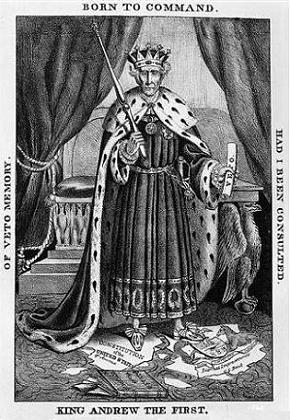 |
| The Whig Party arose in challenge to "King Andrew" Jackson. Ironically, it was Jackson himself who opened the door for the new party to form because his presidency was so domineering that it effectively eradicated America's true two-party system. An attempt on Jackson's life in 1835 was incorrectly blamed on the Whigs. |
|
LIBERTY PARTY
|
FREE SOIL PARTY
|
|
WHIG PARTY
|
AMERICAN PARTY
|
 |
| Distributed by a New York City company, this woodcut presents a parody of the 1840 presidential election in which the Democratic incumbent, Martin Van Buren, was ousted by challenger William Henry Harrison of the newly formed Whig Party. Van Buren (aka "Old Kinderhook" and "Red Fox") appears trapped in a log cabin as party patriarch Andrew Jackson attempts to free him by using an old hickory branch as a lever. But Jackson's efforts are in vain—the bundle (Democratic platform? Van Buren's first term results?) serving as the fulcrum is labeled "NG" for "no go." The "new cider" keg corking the chimney is an important part of the illustration. Harrison supporters totting poles propped with kegs were often visable at Whig campaign rallies. Carved on the cabin are names of several Harrison states which ultimately kept Van Buren confined and therefore unable to return to the White House. (Even though Virginia actually went to Van Buren, the fact that Harrison's running mate, John Tyler, was from Virginia perhaps explains why the state is included on the cabin list.) The so-called "Log Cabin Campaign" reflected the effective Whig strategy of creating the illusion of the suave and luxuriating Van Buren (antithesis of the "common man" championed by Jackson) versus the homespun Harrison, so folksy that he lived in a log cabin. An array of related images surfaced; for example, it was said that Harrison routinely drank ordinary hard cider while Van Buren consumed only expensive foreign wines. In truth, no such socio-economic void separating the two candidates existed. No matter—the grand fabrication enabled the Whigs to score a landslide victory (234-60 electoral votes). The 1840 presidential contest is considered by many historians to be the first "modern" election. The campaign was one of noisy fanfare, bolstered by banners and posters, songs and slogans, yet fuzzy on issues of the day. Indeed, 80% of the eligible voters cast ballots in November. One month after taking office, Harrison was dead from pneumonia developed, at least in part, from exposure to the inclement weather during his lengthy Inaugural Address. |
|
|
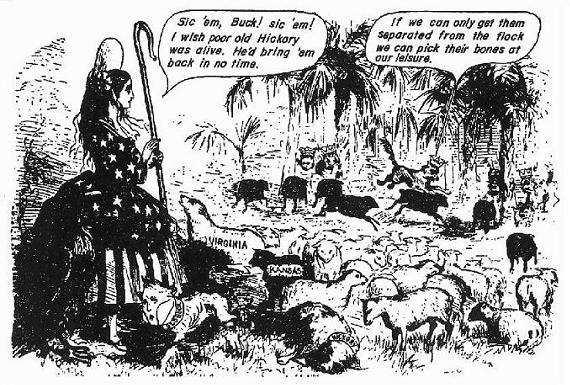 |
| The cartoon above accentuates the sectional turmoil of the 1850s and the Democratic Party's inability to quiet threats of secession. The United States is presented metaphorically as a shepherdess fretful about her flock of sheep and distressed over the federal government's indifference. The message conveyed is two-fold. Allowing the southern states to leave the Union (Kansas and Virginia appear to be looking for the comfort and shelter of their master) would place the estranged states in prime position to be dominated by European powers (wolves lurking nearby for any sheep that might wander from the rest). Further, whereas President James Buchanan ("Old Buck") seems unable and unwilling to provide protective measures (facing away from troubles), former President Andrew Jackson ("Hickory"), deceased since 1845, would have acted to stop secession. Jackson's dynamic leadership style and disdain for states' rights (expressed by his confrontation with South Carolina's Nullification Ordinance and his opposition to the Worcester v. Georgia decision of the Supreme Court) support the cartoonist's presentation. Indeed, in his Second Inaugural Address, Jackson stated: "Without union our independence and liberty would never have been achieved; without union they never can be maintained. The loss of liberty, of all good government, of peace, plenty, and happiness, must inevitably follow a dissolution of the Union." Buchanan's dismal presidential performance paved the way for the newly-formed Republican Party to move into the White House. With the election of Abraham Lincoln in 1860, the Republican hold on the Oval Office continued through 1932, interrupted by only two Presidents—Grover Cleveland (1885-89 and 1893-97) and Woodrow Wilson (1913-21). |
|
STEPHEN DOUGLAS
|
JOHN BRECKENRIDGE
|
|
ABRAHAM LINCOLN
|
JOHN BELL
|
| The decade of the 1850s was ominous to the Deep South. Slavery was on the decline in the border states. There was growing worldwide condemnation of slavery (to be sure, the North was riding this wave). Many southerners feared bloody slave insurrections fueled by northern influence. On a more definitive note, the growth rate of the North likely would produce additional states thus upsetting the free state-slave state balance in Congress and opening the door for solid legislative attacks on slavery. As the turbulent 1850s neared end, the United States confronted the moment of decision regarding disunion—the 1860 presidential election. In February of 1860, the Alabama legislature formally resolved that the state would secede from the Union if a Republican was elected to the White House. Abraham Lincoln's November victory brought immediate action by several southern states. In December, South Carolina turned Alabama's threat into stark reality. Within weeks, six other Deep South states joined South Carolina's exodus. On Inauguration Day, the new President was faced with a national challenge as catastrophic as any crisis in United States history. |
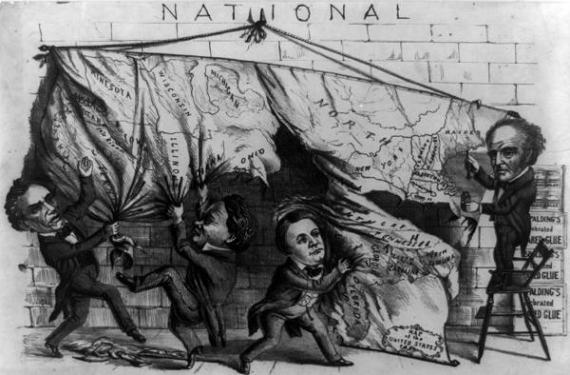 |
| The above cartoon shows the 1860 presidential campaign. As Abraham Lincoln and Stephen Douglas struggle for control of the nation's vote, John Breckenridge tears away the South. John Bell attempts in vain to repair the damage to the torn country. The Republican Party scored a firm November triumph, taking every free state except a fraction of New Jersey. Lincoln's winning margin over Douglas in the North was solid—Lincoln garnered 54 percent of the popular vote. Although less than 40 percent of those who went to the polls throughout the nation actually voted for Lincoln, his support in the North was so resounding that he would have won the necessary electoral votes even if the results of his three opponents could have been combined. It was a bittersweet moment for Lincoln and the Republicans, however, as the political leaders of the South launched an immediate drive for secession from the Union. |
|
SAMUEL TILDEN
|
RUTHERFORD B. HAYES
|
| The election of 1876 pitted Republican candidate Rutherford B. Hayes against Democratic nominee Samuel Tilden. The initial results, dutifully reported by the New York Tribune, indicated apparent victory for Tilden—his advantage of 250,000 popular votes was reflected in the Electoral College, 204-165. However, the electoral votes of three southern states, Florida, Louisiana, and South Carolina, and one additional vote from Oregon came under dispute. The total count of 20 electoral votes in question was just enough that if the entire lot were to somehow move out of the Tilden column to Hayes's side of the ledger, then Hayes would win the election by the very narrowest of margins, 185-184, and the Republican Party would maintain residency in the White House. In the absence of any constitutional prescript, the decision of which returns to accept was placed under the jurisdiction of a special 15-member Electoral Commission composed of five men each from the Senate, House, and Supreme Court. Seven on the committee were Republicans, seven were Democrats, and one, Justice David Davis, was not aligned with either party. The sudden resignation of Davis from the Court, and therefore the Commission, necessitated a replacement that simply was not possible, for all of the remaining justices were Republicans! Hence, the committee's political balance was upset. Two days later, on a straight party vote, the presidency was stolen from Tilden and awarded to Hayes. (It could be argued that justice was served since an estimated quarter-million blacks throughout the South who would have voted Republican were forcibly barred from the polls in the general election. On the other hand, political analysts have concluded that while the black vote would probably have landed Louisiana and South Carolina in the Hayes camp, Florida would likely have gone to Tilden.) To appease the Democrats, key party representatives, meeting at the Wormley Hotel in Washington, culminated an informal understanding historically known as the Compromise of 1877. Although scholars disagree about the specifics of the pact, it appears that whereas the Republicans gained the presidency and southerners' pledge to uphold civil rights, the price was, among other things, withdrawal of federal troops from former Confederate areas still under "military reconstruction" and appointment of at least one southerner to the Hayes Cabinet. Beyond the election itself, the outcome was significant because the affair was settled by diplomacy rather than return to the battlefield. As the Wormley Conference agreement began to materialize under the new administration and it became evident that some degree of election deal had indeed transpired, grumblers referred to the President as "His Fraudulency" and "Rutherfraud" Hayes. The election compromise signified the end of zealous Republican interference with southern treatment of blacks; the Democratic "Solid South" remained a social and political fixture halfway into the next century. |
 |
The adjacent drawing, by renowned political cartoonist Thomas Nast, presents an optimistic (albeit hopelessly utopian) view of national reunification spurred by the Compromise of 1877, by Democratic and Republican party spokesmen just 72 hours prior to Inauguration Day. Astride the Mason-Dixon Line, newly-elected President Rutherford B. Hayes ushers reconciliation of North and South after a dozen years of fruitless Reconstruction tug-o-war between Radical Republicans determined to punish the South for its transgressions against the Union and die-hard southerners ignorant to the reality that the institution of slavery and the idea of secession had both perished forever on the Civil War battlefield of defeat. |
|
DEMOCRATS
was the notable exception), "Solid South" |
REPUBLICANS
farmers of North & West, blacks |
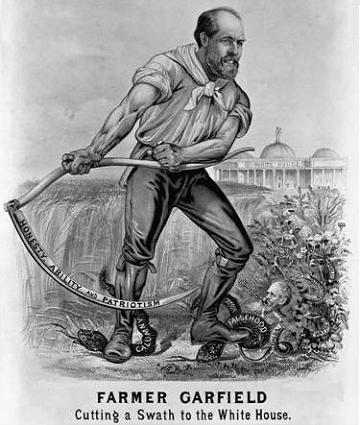 |
| In an era willing to mollify political deceit, this 1880 campaign lithograph by Currier & Ives depicts James Garfield wielding a scythe of "Honesty, Ability and Patriotism" as he resolutely cuts a direct swath to the White House through problematic brush infested with villainous snakes. Garfield tramples "Calumny" and "Falsehood." One snake even bears the likeness of Garfield's predecessor, Rutherford B. Hayes! Ironically, Hayes was an honest President. He had nothing to do with the politically generated Compromise of 1877 which pulled the White House rug out from under Samuel Tilden. On the other hand, Garfield's political past was somewhat tainted. He had been mildly linked to the Crédit Mobilier railroad scandal of Ulysses S. Grant's presidency. The implications were circumstantial only; no adjudication against Garfield ever materialized. Historians generally agree that Garfield's action reflected a relatively minor lapse in ethics propagated by political naiveté rather than flawed integrity. The strategy of this drawing is to completely exonerate Garfield by implying that Hayes is a dishonest politician. Garfield became the only man ever elected to the presidency straight from the House of Representatives and was, for a brief time, a sitting Representative, Senator-elect, and President-elect concurrently. Technically, he was the first senator to be elected President, although he never actually sat in the Senate, as the term was not scheduled to begin until 1881. |
|
|
| The Populist Party (aka the People's Party) was created to lift the debt of the working force, especially the farmer, and give people a greater voice in government. According to the Populists, greed and privilege had upset the balance between work and reward. Americans who raised crops and made products were being impoverished while those who raised rates and made deals were becoming disproportionately rich. The roots of the party can be traced back to the Patrons of Husbandry (aka the Grange), founded in 1867 by Oliver Kelley. Soon several other organizations, known as Farmers' Alliances, formed to protest decling prices for agricultural products, increased shipping rates charged by railroads, and burdensome mortgages. Although some of the complaints were exaggerated, they nevertheless provided a common axis around which the various agrarian groups rallied. In 1892, several of these farming alliances banded in Omaha, Nebraska, to formulate what is referred to historically as the Omaha Platform (an offspring of the Ocala Demands of 1890). The party experienced immediate success. James Weaver of Iowa emerged from the Omaha Convention as the Populists' presidential candidate. Weaver garnered almost ten percent of the national popular vote, winning four states and portions of two others for 22 total electoral votes. Although falling short in the presidential election, the Populists placed governors in Kansas and North Dakota, won 15 seats in Congress (ten in the House; five in the Senate), and elected some 1,500 state lawmakers. The Populist Party's decline was as sudden as its success—the 1894 congressional and gubernatorial elections were disappointing. As a result, the Populists fused with the Democrats for the 1896 presidential campaign, backing William Jennings Bryan, the "Boy Orator of the Platte" (realizing that to choose a candidate other than Bryan would split the anti-McKinley vote and assure a Republican victory). But in order to promote its Omaha Platform and retain some degree of party identity, coupled with dissatisfaction over Bryan's running mate (wealthy Maine banker Arthur Sewall, who seemed indifferent to issues facing farmers), the Populist Party resorted to an odd strategy—naming a separate vice-presidential candidate (Tom Watson of Georgia). Bryan's defeat was the last serious effort of any party to win the White House with mostly agrarian votes. The outcome resonated America's post-Civil War transition from a rural, agricultural country to an urban, industrial nation. It also heralded a Republican grip on the White House broken only once through 1932. The 1896 election marks the effective end of the short-lived Populist Party. Within months, the party began to collapse. However, its impact on political America was profound. Most of the Populists' reform agenda was adopted by the Democratic Party and enacted at various times during the twentieth century. |
 |
| "Party of Patches" is the caption accompanying this cartoon, highly critical of the People's Party, officially founded in Cincinnati in 1891. The balloon, fashioned from several incongruous pieces, appears unstable and misguided. Riding in the "platform of lunacy" are four prominent party leaders. Terence Powderly (doffing his hat) headed the Knights of Labor from 1879 through 1893. The organization formed one union out of skilled and unskilled workers alike rather than separating members by craft. Next to Powderly is Ignatius Donnelly (wearing the top hat), a Minnesota politician known for attaching to several third-party movements during the course of his public career. Sensitive to the plight of minorities, Donnelly advocated expanding authority of the Freedmen's Bureau during Reconstruction and was an early supporter of women's suffrage. In 1892, he wrote the preamble to the Populist Party's celebrated Omaha Platform. The next two gentlemen were Kansas politicians. Jerry "Sockless" Simpson (wearing glasses) was elected to the House of Representatives. When he once described a political opponent as a pampered product of wealth whose feet were "encased in fine silk hosiery," Simpson was admonished that having silk socks was better than having none at all. William Peffer (with the long white beard) was the Populist Party's first Washington senator. He was a humorous figure to many journalists and politicians in the East, who saw little evidence of Populism in their states and often viewed the party as folly. |
|
|
|
WILLIAM HOWARD TAFT
|
THEODORE ROOSEVELT
|
|
WOODROW WILSON
|
EUGENE DEBS
|
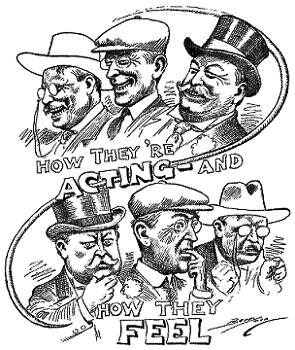 |
The race for the White House in 1912 was a three-way affair involving the Presidents (past, incumbent, and future) of the Progressive Era—Theodore Roosevelt, William Howard Taft, and Woodrow Wilson. Generally considered the greatest of the Oval Office Progressives, Roosevelt provided numerous labor reforms through his "Square Deal" measures. Identified historically as "trust-buster" (i.e., dissolve monopolies), the more accurate description of his behavior toward big business would be "trust-regulator" (i.e., disarm monopolies). Roosevelt is also regarded as the presidential pioneer in conservation of America's natural resources. His enormous popularity among fellow Republicans allowed him to dictate his successor in 1908. Taft was somewhat of a disappointment. Despite filing nearly 90 anti-trust suits, more than twice that of the previous administration, Taft was unable to maintain Roosevelt's wave of reform. Hence, some grousing within the party. The Republican rift under Taft opened the door for the Democratic Party to gain the presidency in 1912. Many historians view Wilson as the most scholarly man to occupy the White House since John Quincy Adams. Wilson's "New Freedom" program was committed to restoring open competition instead of simply regulating monopolies. For all that the short-lived Progressive Era accomplished, it largely ignored the issue of racial equality. Segregation became more unyielding; white opposition to black voting rights increased; Ku Klux Klan lynchings went unpunished. Wilson did nothing to combat this glaring blemish on the otherwise commendable Progressive record. |
|
|
|
|
|
STATES' RIGHTS
|
PROGRESSIVES
|
|
DEMOCRATS
Society" (1961 thru 1969) |
REPUBLICANS
the 1970s) |
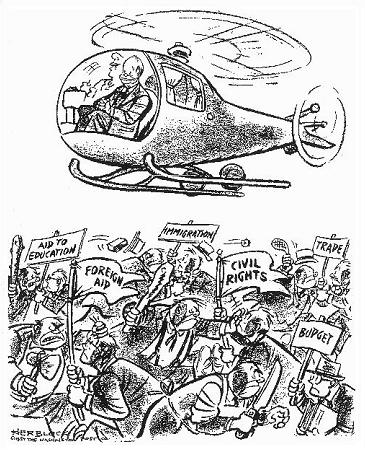 |
| President Dwight D. Eisenhower was routinely chastised by Liberals, as with this Herbert Block cartoon published in the Washington Post, for his apparent indifference to many mounting social issues of the time. Eisenhower's failure to employ his vast prestige on behalf of civil rights is especially conspicuous. |
|
JOHN F. KENNEDY
|
RICHARD NIXON
|
| In the weeks prior to the 1960 election, Democrat John F. Kennedy and Republican Richard Nixon faced each other in the country's first televised debate between presidential contenders. The idea was Kennedy's, but the Nixon camp readily accepted—the strategy was to use Nixon's political mastery to distance himself from his relatively unknown challenger. The first debate (there were four total) was pivotal in fixing voters' perceptions of the two candidates. Nixon, recovering from illness that required hospitalization, appeared haggard and gaunt. His entire presentation sputtered. On the other hand, Kennedy was confident and relaxed. He had planned well—some recent time under the California sun illuminated his handsome looks and sturdy physique, and unlike his opponent, Kennedy scheduled a day off from the hectic campaign trail to rest and prepare for the big night. Whereas most of the American public listeners to the debate's radio broadcast scored Nixon over Kennedy, the majority of television viewers were mesmerized by JFK. Indeed, New York Times journalist Russell Baker concluded, "That night, television replaced newspapers as the most important communications medium in American politics." In the subsequent debates, Nixon managed to revive some of the spit and vinegar he displayed as Vice-President when, in 1959, he engaged Nikita Khrushchev in the memorable impromptu "kitchen debate" (even jabbing a finger in the chest of the Soviet leader), but the damage was done. The election was the closest in history. After an exhausting election night, Kennedy retired at 3:00 a.m. eight electoral votes shy of victory; he was awakened three hours later with good news. America's version of Camelot officially commenced on January 20, 1961, when the youngest man elected to the White House concluded his Inaugural Address with perhaps the most memorable statement in presidential history: "My fellow Americans, ask not what your country can do for you; ask what you can do for your country." |
|
DEMOCRATS
party standard-bearer |
REPUBLICANS
extremes |
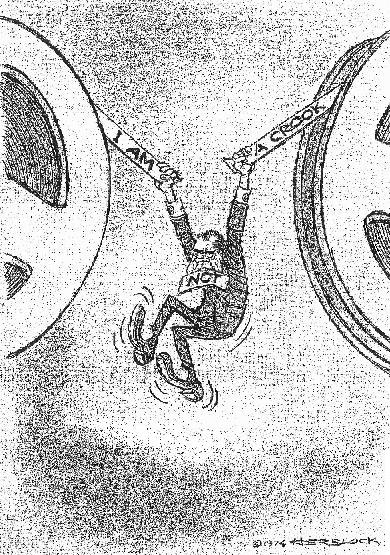 |
| At about the time the American public was becoming aware that there was more to know about the Watergate break-in than what the government had so far revealed, President Richard Nixon assured America, "I am not a crook." The facts would soon show otherwise—largely due to the content of several Oval Office tapes. Ironically, it had been Nixon himself who developed the idea of recording his White House conversations for the purpose of historical posterity. When directed to submit the tapes, the President balked (citing "executive privilege"), but soon was ordered to comply by the Supreme Court. One of the tapes contained a particularly damning erasure of 18½ minutes in which Nixon allegedly authorized monetary payment to buy the Watergate burglers' silence. His party support rapidly deserting him, Nixon resigned in August of 1974 amid televised impeachment hearings conducted by the House Judiciary Committee that would have undoubtedly forced his premature removal. That action garnered Nixon the dubious distinction of being the first Chief Executive to exit his term early. Hence, the clever Herblock cartoon above. Nixon's presidency is one of the three most corrupt in history. Ulysses S. Grant and Warren G. Harding also hosted notorious executive branch misbehavior. Importantly, two clear differences separate the dishonesty associated with Grant and Harding from that of Nixon. Whereas Grant and Harding were themselves honest and apparently unaware of the various schenanigans committed behind their backs, Nixon was a knowing participant in the Watergate cover-up. And, while the Whiskey Ring et al. under Grant and the Teapot Dome et al. of Harding were generated to produce financial gain, Watergate conspirators were motivated by a lust for political power. |
|
HUBERT HUMPHREY
|
GEORGE WALLACE
|
|
RICHARD NIXON
|
|
| Richard Nixon emerged from the political discard pile to become President. Riding high after serving as Vice-President in the Eisenhower administration, Nixon narrowly lost to JFK in the 1960 presidential race, then was denied two years later in his bid for the California governorship. Nixon's rapid fall from favor caused him to exit politics until his sudden second try at the White House in 1968. Nixon's 1972 re-election occurred in the midst of the Watergate cover-up. The American public was not yet aware of the large extent to which Nixon and his people were involved in Watergate and other illegal activities. (Within a few years, over 40 officials within the Nixon administration, including the President himself, would be named in criminal indictments.) Ironically, it was Nixon’s perceived "law and order" agenda, with America mired in the chaos of widespread race riots and the Vietnam fiasco, that appealed to so many voters. Nixon’s Democratic challenger was liberal "peace candidate" Senator George McGovern of South Dakota. McGovern’s campaign took a major hit when it was revealed that his running mate, Senator Thomas Eagleton of Missouri, had undergone rather intense psychiatric therapy several years earlier. Although McGovern promised to retain Eagleton, party officials were convinced that Eagleton had become a campaign liability. Abandoning Eagleton was one thing; replacing him was another matter. Several prominent party figures—including Hubert Humphrey, Edward Kennedy, Edmund Muskie, and Abraham Ribicoff—refused to board the fast-sinking Democratic flagship. McGovern was forced to settle for Sargent Shriver, whose political résumé was decidedly scant. The Democrats had hoped to prosper from the Twenty-sixth Amendment, which allowed 18-year-olds to vote for the first time. Instead, McGovern suffered a landslide defeat, winning just 17 electoral votes. After the election, the White House "plumbers" worked overtime to prevent leaks, but still the ugly details of Watergate trickled out. Dogged investigation by Washington Post reporters Bob Woodward and Carl Bernstein (aided by their high-level secret source identified only as "Deep Throat" as well as taped Oval Office conversations between the President and all his lackeys) exposed the Nixon administration's assault on American democracy. In August of 1974, Nixon resigned in the face of dire consequences and humiliating legacy of impending impeachment proceedings. |
 |
| Democrats approached the 1972 presidential election—the ominous possibility of four more years of Richard Nixon looming—confounded over party leadership. Those whose candles burned brightest appear in this cartoon. Minnesota's Hubert Humphrey served as Vice-President under Lyndon B. Johnson, then became the Democratic candidate for President in 1968, narrowly losing to Nixon. Senator Edward "Ted" Kennedy of Massachusetts was the youngest of the trio of brother politicians. Though he never managed to position himself for his party's presidential endorsement, his political career and influence extended long after the others featured in this drawing had faded from the national stage. Speaker of the House Carl Albert of Oklahoma chaired the stormy 1968 Democratic National Convention held in Chicago which epitomized not only the Democratic disarray, but the nation's chaos, as well. When Nixon's Vice-President, Spiro Agnew, resigned in late 1973 due to various improprieties, the President nominated Republican House Minority Leader Gerald R. Ford of Michigan to secede Agnew. As the Watergate crisis began to unravel, there was reason to think that Nixon might resign before both Houses of Congress could confirm the Ford appointment. Had that schenario transpired, Albert would have become Acting President under the Presidential Succession Act of 1947. Senator (former Governor) Edmund Muskie of Maine was Humphrey's running mate in 1968. Muskie's 1972 run for the White House was derailed by dirty politics of Nixon cronies who fabricated politically embarrasing circumstances for Muskie, irrevocably damaging his national image. Muskie was a strong ally of environmentalists. He later served as Secretary of State under President Jimmy Carter. Henry "Scoop" Jackson was a Washington-state politician (House and Senate) known as a staunch Cold War anti-communist hawk. In 1960, he had been highly considered for JFK's vice-presidential running mate. Senator George McGovern of South Dakota emerged from the cluster of Democratic hopefuls as the party's 1972 candidate. Recognized as a "peace candidate," McGovern advocated immediate withdrawal from Vietnam once all POWs were returned, decreasing America's military strength in Europe, and amnesty for some draft dodgers. He suffered a crushing defeat to incumbent Nixon, winning only Massachusetts and the District of Columbia. Also shown in the cartoon are Senator Birch Bayh of Indiana and Senator (former Governor) Harold Hughes from Iowa. |
|
DEMOCRATS
|
REPUBLICANS
|
 |
| The message conveyed by the cartoon above is clear. President Ronald Reagan is portrayed dancing with a robust lady while others, though not malnourished, are nevertheless obviously impatient and frustrated as they await their chance for Reagan's attention. In fact, Reagan seems somewhat oblivious to the other women. |